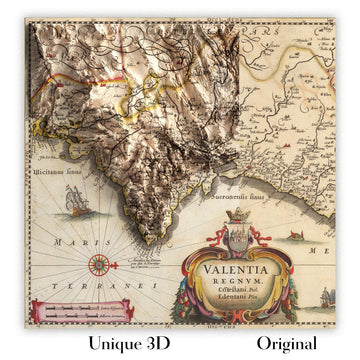

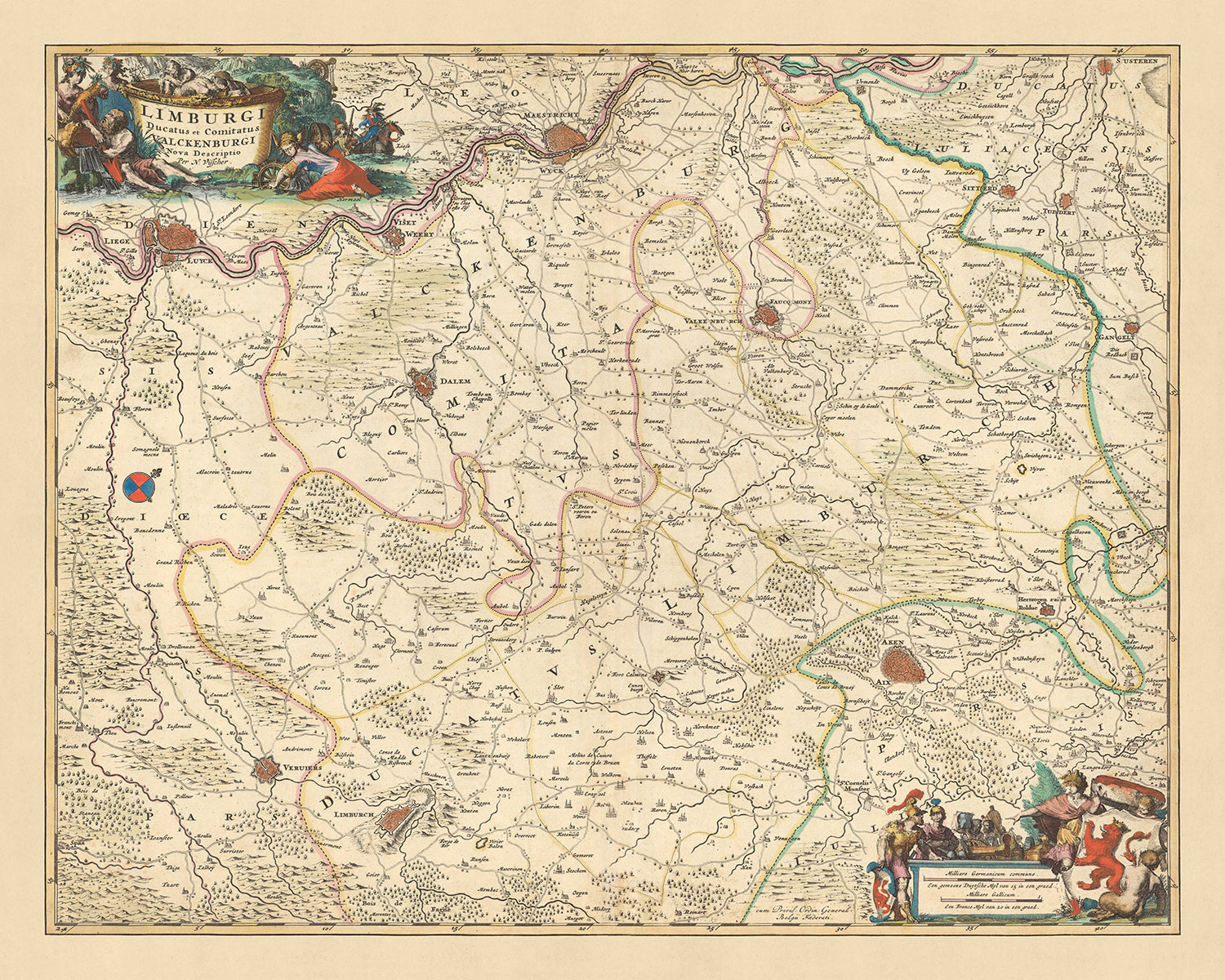

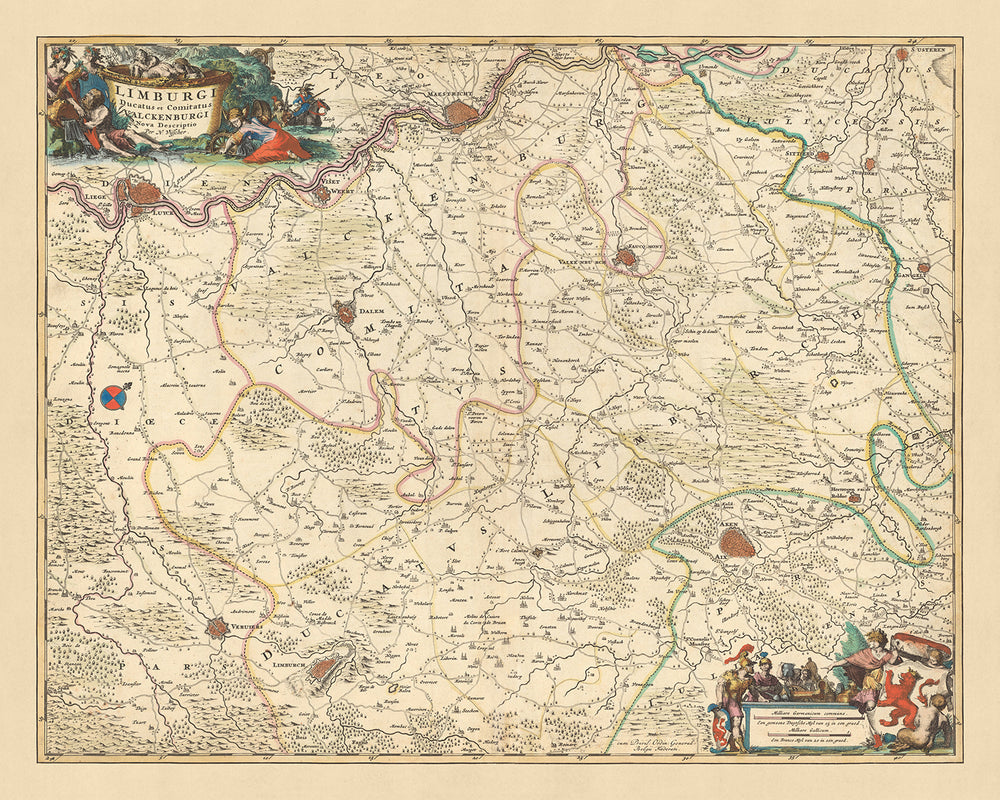

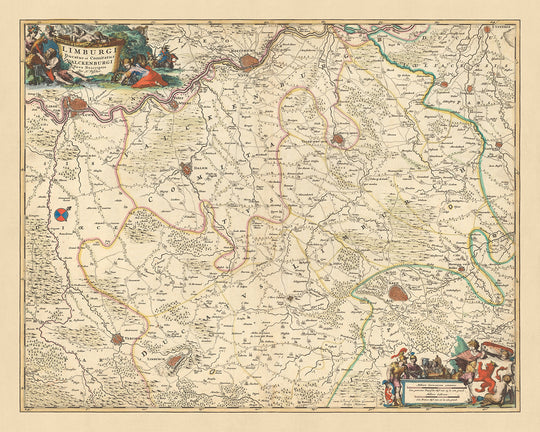











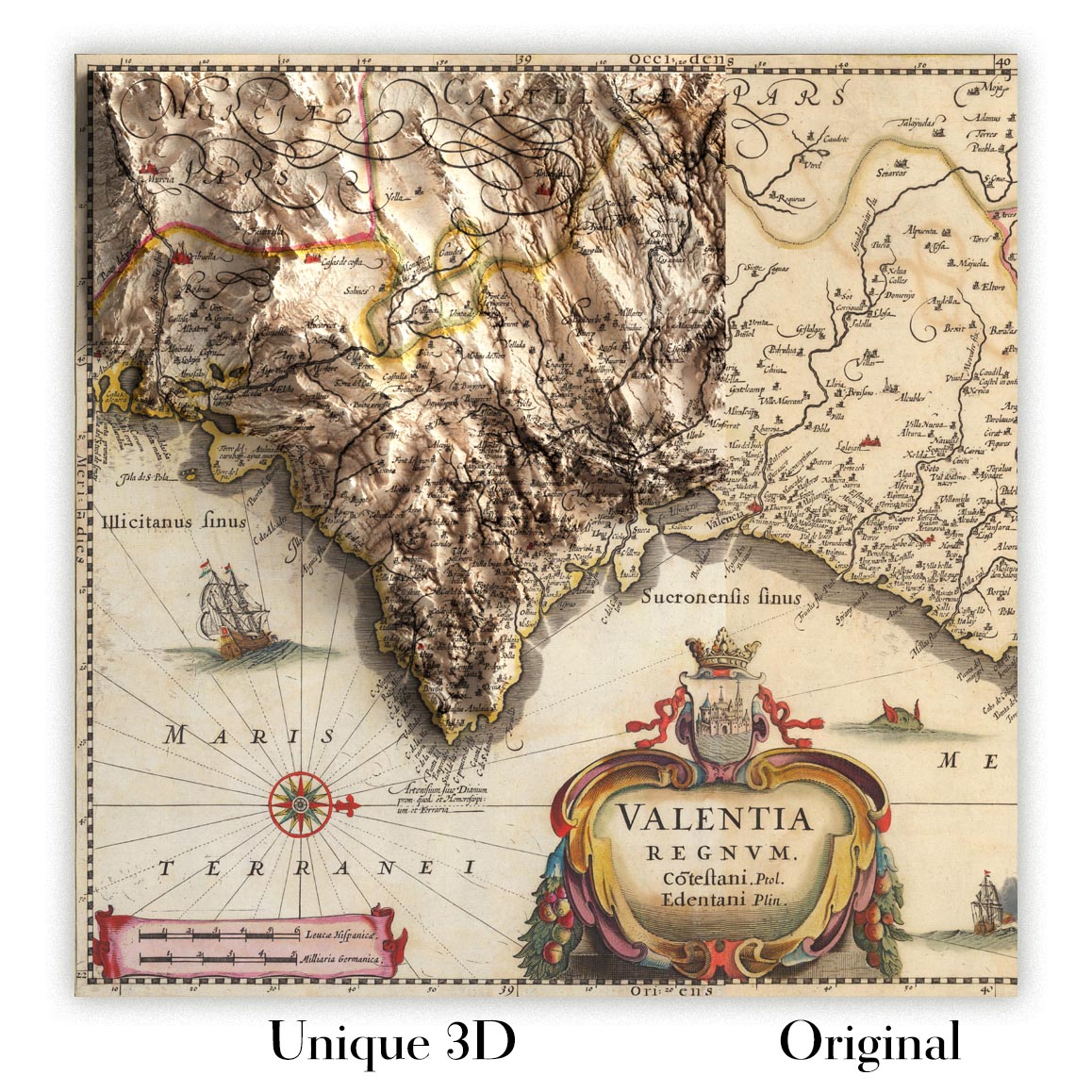



Old Map of Duchy of Limburg & County of Valkenburg by Visscher, 1690: Liège, Aachen, Maastricht, Verviers, Heerlen


-
![]() Handmade locally in the EU
Handmade locally in the EU
-
FREE worldwide delivery in 2-3 days ⓘ
Free delivery in 2-3 days
Your map should be delivered in 2-3 working days with free delivery, worldwide.
We make maps by hand locally in 23 countries, including the EU
![]() . If you're buying a gift for someone in another country, we will make the map locally to them.
. If you're buying a gift for someone in another country, we will make the map locally to them.You will never pay import tax or customs duty.
Express delivery is available at checkout which can reduce the delivery time to 1-2 days.
Please note that personalised maps, and larger framed maps, can take longer to produce and deliver.
If you need your order to arrive by a certain date, contact me and we can discuss your options.
-
90 day money back guarantee
ⓘ
90 days to return and refund
Products can be returned within 90 days for a full refund, or exchange for another product.
For personalised or custom made items, we may offer you store credit or a non-expiring gift card, as we cannot resell personalised orders.
If you have any questions, get in touch. For more information, see our full returns & exchanges policy.

My maps are rare, museum-grade, restored old maps sourced from libraries, auction houses and private collections across the globe.
Framing & free personalisation available
1. Select your size
➢ Pick the closest size (above)
➢ Provide the exact size in millimetres
➢ Add to bag and checkout as normal
Click here to order a custom size.
2. Frame & personalise your map
Make your map unique with framing, hand-drawn customisation, vintage ageing, pop art text, unique 3D styling and moreGift message & custom finish

If you want to add a gift message, or a finish (jigsaw, aluminium board, etc.) that is not available here, please request it in the "order note" when you check out.
Every order is custom made, so if you need the size adjusted slightly, or printed on an unusual material, just let us know. We've done thousands of custom orders over the years, so there's (almost) nothing we can't manage.
You can also contact us before you order, if you prefer!

- Handmade locally. No import duty or tax
- FREE Delivery. Arrives in 2-3 days
- Love it or your money back
- Questions? WhatsApp me any time
Own a piece of history
5,000+ 5 star reviews


Discover the rich history and intricate geography of the Duchy of Limburg and County of Valkenburg with this stunning map crafted by Nicolaes Visscher II in 1690. The full name of the map, 'Limburgi Ducatus et Comitatus Valckenburgi nova descriptio', translates to 'New Description of the Duchy of Limburg and the County of Valkenburg', indicating the areas of focus on this historical piece.
The map prominently features five significant locations: Liège, Aachen, Maastricht, Verviers, and Heerlen. Each city is a treasure trove of history and culture. Liège, a vibrant city in Belgium, was a significant medieval principality. Aachen, in modern-day Germany, was the place where German kings were crowned and is known for its cathedral, a UNESCO World Heritage site. Maastricht, a city in the Netherlands, is known for its Roman history and vibrant cultural scene. Verviers, another Belgian city, was once a significant textile town. Lastly, Heerlen, a city in the Netherlands, was known for its Roman baths, the Thermae, one of the most notable Roman sites north of the Alps.
The map also captures the political divisions of the time, providing a fascinating glimpse into the past. The Duchy of Limburg and the County of Valkenburg were important regions in the 17th century, and this map provides a detailed view of their borders and subdivisions. This map is not just a geographical representation, but also a historical document that reflects the political landscape of the era.
Nicolaes Visscher II, the creator of this map, comes from a lineage of renowned Dutch cartographers. His grandfather, Claes Janszoon Visscher, was one of the finest mapmakers from the Dutch Golden Age. Nicolaes Visscher II carried forward this legacy, creating maps that were not only accurate but also aesthetically pleasing. This map of the Duchy of Limburg and County of Valkenburg is a testament to his skill and craftsmanship.
This map offers a unique blend of art, history, and geography, making it a perfect addition to any collection. Whether you're a history enthusiast, a lover of maps, or someone who appreciates fine art, this map of the Duchy of Limburg and County of Valkenburg is sure to captivate and inspire.
Some of the significant locations shown on this map:
Duchy of Limburg
- Liège: Known as Leodium in Latin, Liège was a significant medieval principality. It's now a vibrant city in Belgium.
- Verviers: Once a significant textile town in Belgium, known historically as Vervia.
- Huy: A Belgian city known for its fortress, historically known as Hoei.
- Visé: Known as Wezet in Dutch, it's a Walloon city located on the river Meuse.
- Herstal: Known as Heristal, or Herstelle in the old Limburgish language, it's a city in the Walloon region of Belgium.
- Seraing: Known as Sarins in Walloon, it's an industrial city in Belgium.
- Oupeye: A municipality of Belgium, known as Oepia in Walloon.
- Blegny: Known for its coal mines, it's a Walloon municipality in Belgium.
- Fléron: A Walloon municipality located in the Belgian province of Liège.
- Chaudfontaine: Known for its hot springs, it's a Belgian town located in the province of Liège.
- Esneux: A Walloon municipality located in the Belgian province of Liège.
- Amay: Known historically as Amaye, it's a Belgian municipality located in the Walloon region.
- Waremme: Known as Borgworm in Dutch, it's a city and municipality located in the province of Liège.
- Saint-Georges-sur-Meuse: Known as Sint-Joris in Dutch, it's a municipality of Belgium.
- Awans: A Walloon municipality located in the Belgian province of Liège.
County of Valkenburg
- Maastricht: Known for its Roman history and vibrant cultural scene, it's a city in the Netherlands.
- Heerlen: Known for its Roman baths, the Thermae, one of the most notable Roman sites north of the Alps.
- Valkenburg: Known for its castle, it's a city in the province of Limburg in the Netherlands.
- Geleen: Known as Gelaen in Limburgish, it's a city in the southern part of the province of Limburg in the Netherlands.
- Sittard: One of the oldest towns in the Netherlands, it's located in the southern province of Limburg.
- Kerkrade: Known for its historical architecture, it's a town and a municipality in the southeast of Limburg.
- Landgraaf: Known for its annual Pinkpop Festival, it's a municipality in the province of Limburg in the Netherlands.
- Brunssum: Known for its nature areas, it's a municipality and a town in the province of Limburg in the Netherlands.
- Gulpen: Known as Gullepe in Limburgish, it's a town in the southern part of the Netherlands.
- Wittem: Known for its castle, it's a town in the Dutch province of Limburg.
- Eijsden: Known for its castle, it's a town in the southernmost part of the Netherlands.
- Margraten: Known for its war cemetery, it's a village in the Dutch province of Limburg.
- Meerssen: Known for its Basilica, it's a place in the Dutch province of Limburg.
- Schin op Geul: Known for its scenic beauty, it's a village in the Dutch province of Limburg.
- Voerendaal: Known for its historic houses and castles, it's a municipality and a town in the southeastern Netherlands.
Notable Boundaries and Natural Phenomena
- River Meuse: A major European river, rising in France and flowing through Belgium and the Netherlands before draining into the North Sea.
- High Fens: A high moorland area, it's the largest nature reserve in Belgium.
- Ardennes: A region of extensive forests, rolling hills and ridges in Belgium, Luxembourg, and France.
- Hoge Kempen National Park: The first National Park in Flanders, Belgium, it's known for its pine forests and large heathlands.
- Caves of Remouchamps: A tourist attraction in Belgium, known for its 600 m long underground river.
Notable Historical Events (1600-1690)
- Battle of Maastricht (1673): During the Franco-Dutch War, the city of Maastricht was besieged by the French under the command of Louis XIV.
- Treaty of Nijmegen (1678): This series of treaties ended various interconnected wars among France, the Dutch Republic, Spain, Brandenburg, Sweden, Denmark, the Prince-Bishopric of Münster, and the Holy Roman Empire.
- Rampjaar (1672): Known as the "Disaster Year", the Dutch Republic was simultaneously attacked by England, France, and the Bishoprics of Münster and Cologne.
Please double check the images to make sure that a specific town or place is shown on this map. You can also get in touch and ask us to check the map for you.
This map looks great at all sizes: 12x16in (30.5x41cm), 16x20in (40.5x51cm), 18x24in (45.5x61cm), 24x30in (61x76cm), 32x40in (81.5x102cm), 40x50in (102x127cm), 48x60in (122x153cm) and 56x70in (142x178cm), but it looks even better when printed large.
I can create beautiful, large prints of this map up to 90in (229cm). Please get in touch if you're looking for larger, customised or different framing options.
The model in the listing images is holding the 16x20in (40.5x51cm) version of this map.
The fifth listing image shows an example of my map personalisation service.
If you’re looking for something slightly different, check out my collection of the best old maps of Europe and European cities to see if something else catches your eye.
Please contact me to check if a certain location, landmark or feature is shown on this map.
This would make a wonderful birthday, Christmas, Father's Day, work leaving, anniversary or housewarming gift for someone from the areas covered by this map.
This map is available as a giclée print on acid free archival matte paper, or you can buy it framed. The frame is a nice, simple black frame that suits most aesthetics. Please get in touch if you'd like a different frame colour or material. My frames are glazed with super-clear museum-grade acrylic (perspex/acrylite), which is significantly less reflective than glass, safer, and will always arrive in perfect condition.
This map is also available as a float framed canvas, sometimes known as a shadow gap framed canvas or canvas floater. The map is printed on artist's cotton canvas and then stretched over a handmade box frame. We then "float" the canvas inside a wooden frame, which is available in a range of colours (black, dark brown, oak, antique gold and white). This is a wonderful way to present a map without glazing in front. See some examples of float framed canvas maps and explore the differences between my different finishes.
For something truly unique, this map is also available in "Unique 3D", our trademarked process that dramatically transforms the map so that it has a wonderful sense of depth. We combine the original map with detailed topography and elevation data, so that mountains and the terrain really "pop". For more info and examples of 3D maps, check my Unique 3D page.
For most orders, delivery time is about 3 working days. Personalised and customised products take longer, as I have to do the personalisation and send it to you for approval, which usually takes 1 or 2 days.
Please note that very large framed orders usually take longer to make and deliver.
If you need your order to arrive by a certain date, please contact me before you order so that we can find the best way of making sure you get your order in time.
I print and frame maps and artwork in 23 countries around the world. This means your order will be made locally, which cuts down on delivery time and ensures that it won't be damaged during delivery. You'll never pay customs or import duty, and we'll put less CO2 into the air.
All of my maps and art prints are well packaged and sent in a rugged tube if unframed, or surrounded by foam if framed.
I try to send out all orders within 1 or 2 days of receiving your order, though some products (like face masks, mugs and tote bags) can take longer to make.
If you select Express Delivery at checkout your order we will prioritise your order and send it out by 1-day courier (Fedex, DHL, UPS, Parcelforce).
Next Day delivery is also available in some countries (US, UK, Singapore, UAE) but please try to order early in the day so that we can get it sent out on time.
My standard frame is a gallery style black ash hardwood frame. It is simple and quite modern looking. My standard frame is around 20mm (0.8in) wide.
I use super-clear acrylic (perspex/acrylite) for the frame glass. It's lighter and safer than glass - and it looks better, as the reflectivity is lower.
Six standard frame colours are available for free (black, dark brown, dark grey, oak, white and antique gold). Custom framing and mounting/matting is available if you're looking for something else.
Most maps, art and illustrations are also available as a framed canvas. We use matte (not shiny) cotton canvas, stretch it over a sustainably sourced box wood frame, and then 'float' the piece within a wood frame. The end result is quite beautiful, and there's no glazing to get in the way.
All frames are provided "ready to hang", with either a string or brackets on the back. Very large frames will have heavy duty hanging plates and/or a mounting baton. If you have any questions, please get in touch.
See some examples of my framed maps and framed canvas maps.
Alternatively, I can also supply old maps and artwork on canvas, foam board, cotton rag and other materials.
If you want to frame your map or artwork yourself, please read my size guide first.
My maps are extremely high quality reproductions of original maps.
I source original, rare maps from libraries, auction houses and private collections around the world, restore them at my London workshop, and then use specialist giclée inks and printers to create beautiful maps that look even better than the original.
My maps are printed on acid-free archival matte (not glossy) paper that feels very high quality and almost like card. In technical terms the paper weight/thickness is 10mil/200gsm. It's perfect for framing.
I print with Epson ultrachrome giclée UV fade resistant pigment inks - some of the best inks you can find.
I can also make maps on canvas, cotton rag and other exotic materials.
Learn more about The Unique Maps Co.
Map personalisation
If you're looking for the perfect anniversary or housewarming gift, I can personalise your map to make it truly unique. For example, I can add a short message, or highlight an important location, or add your family's coat of arms.
The options are almost infinite. Please see my map personalisation page for some wonderful examples of what's possible.
To order a personalised map, select "personalise your map" before adding it to your basket.
Get in touch if you're looking for more complex customisations and personalisations.
Map ageing
I have been asked hundreds of times over the years by customers if they could buy a map that looks even older.
Well, now you can, by selecting Aged before you add a map to your basket.
All the product photos you see on this page show the map in its Original form. This is what the map looks like today.
If you select Aged, I will age your map by hand, using a special and unique process developed through years of studying old maps, talking to researchers to understand the chemistry of aging paper, and of course... lots of practice!
If you're unsure, stick to the Original colour of the map. If you want something a bit darker and older looking, go for Aged.
If you are not happy with your order for any reason, contact me for a no-quibble refund. Please see our returns and refund policy for more information.
I am very confident you will like your restored map or art print. I have been doing this since 1984. I'm a 5-star Etsy seller. I have sold tens of thousands of maps and art prints and have over 5,000 real 5-star reviews.
I use a unique process to restore maps and artwork that is massively time consuming and labour intensive. Hunting down the original maps and illustrations can take months. I use state of the art and eye-wateringly expensive technology to scan and restore them. As a result, I guarantee my maps and art prints are a cut above the rest - that's why I can offer a no-quibble refund.
Almost all of my maps and art prints look amazing at large sizes (200cm, 6.5ft+) and I can frame and deliver them to you as well, via special oversized courier. Contact me to discuss your specific needs.
Or try searching for something!
This service is currently unavailable,
sorry for the inconvenience.
Pair it with a frame
Frame options are for visualization purposes only.
FRAME STYLE
MATTING SIZE
BUILDING YOUR EXPERIENCE
powered by Blankwall
Take a few steps back and let your camera see more of the scene.
powered by Blankwall
Was this experience helpful?
Discover the rich history and intricate geography of the Duchy of Limburg and County of Valkenburg with this stunning map crafted by Nicolaes Visscher II in 1690. The full name of the map, 'Limburgi Ducatus et Comitatus Valckenburgi nova descriptio', translates to 'New Description of the Duchy of Limburg and the County of Valkenburg', indicating the areas of focus on this historical piece.
The map prominently features five significant locations: Liège, Aachen, Maastricht, Verviers, and Heerlen. Each city is a treasure trove of history and culture. Liège, a vibrant city in Belgium, was a significant medieval principality. Aachen, in modern-day Germany, was the place where German kings were crowned and is known for its cathedral, a UNESCO World Heritage site. Maastricht, a city in the Netherlands, is known for its Roman history and vibrant cultural scene. Verviers, another Belgian city, was once a significant textile town. Lastly, Heerlen, a city in the Netherlands, was known for its Roman baths, the Thermae, one of the most notable Roman sites north of the Alps.
The map also captures the political divisions of the time, providing a fascinating glimpse into the past. The Duchy of Limburg and the County of Valkenburg were important regions in the 17th century, and this map provides a detailed view of their borders and subdivisions. This map is not just a geographical representation, but also a historical document that reflects the political landscape of the era.
Nicolaes Visscher II, the creator of this map, comes from a lineage of renowned Dutch cartographers. His grandfather, Claes Janszoon Visscher, was one of the finest mapmakers from the Dutch Golden Age. Nicolaes Visscher II carried forward this legacy, creating maps that were not only accurate but also aesthetically pleasing. This map of the Duchy of Limburg and County of Valkenburg is a testament to his skill and craftsmanship.
This map offers a unique blend of art, history, and geography, making it a perfect addition to any collection. Whether you're a history enthusiast, a lover of maps, or someone who appreciates fine art, this map of the Duchy of Limburg and County of Valkenburg is sure to captivate and inspire.
Some of the significant locations shown on this map:
Duchy of Limburg
- Liège: Known as Leodium in Latin, Liège was a significant medieval principality. It's now a vibrant city in Belgium.
- Verviers: Once a significant textile town in Belgium, known historically as Vervia.
- Huy: A Belgian city known for its fortress, historically known as Hoei.
- Visé: Known as Wezet in Dutch, it's a Walloon city located on the river Meuse.
- Herstal: Known as Heristal, or Herstelle in the old Limburgish language, it's a city in the Walloon region of Belgium.
- Seraing: Known as Sarins in Walloon, it's an industrial city in Belgium.
- Oupeye: A municipality of Belgium, known as Oepia in Walloon.
- Blegny: Known for its coal mines, it's a Walloon municipality in Belgium.
- Fléron: A Walloon municipality located in the Belgian province of Liège.
- Chaudfontaine: Known for its hot springs, it's a Belgian town located in the province of Liège.
- Esneux: A Walloon municipality located in the Belgian province of Liège.
- Amay: Known historically as Amaye, it's a Belgian municipality located in the Walloon region.
- Waremme: Known as Borgworm in Dutch, it's a city and municipality located in the province of Liège.
- Saint-Georges-sur-Meuse: Known as Sint-Joris in Dutch, it's a municipality of Belgium.
- Awans: A Walloon municipality located in the Belgian province of Liège.
County of Valkenburg
- Maastricht: Known for its Roman history and vibrant cultural scene, it's a city in the Netherlands.
- Heerlen: Known for its Roman baths, the Thermae, one of the most notable Roman sites north of the Alps.
- Valkenburg: Known for its castle, it's a city in the province of Limburg in the Netherlands.
- Geleen: Known as Gelaen in Limburgish, it's a city in the southern part of the province of Limburg in the Netherlands.
- Sittard: One of the oldest towns in the Netherlands, it's located in the southern province of Limburg.
- Kerkrade: Known for its historical architecture, it's a town and a municipality in the southeast of Limburg.
- Landgraaf: Known for its annual Pinkpop Festival, it's a municipality in the province of Limburg in the Netherlands.
- Brunssum: Known for its nature areas, it's a municipality and a town in the province of Limburg in the Netherlands.
- Gulpen: Known as Gullepe in Limburgish, it's a town in the southern part of the Netherlands.
- Wittem: Known for its castle, it's a town in the Dutch province of Limburg.
- Eijsden: Known for its castle, it's a town in the southernmost part of the Netherlands.
- Margraten: Known for its war cemetery, it's a village in the Dutch province of Limburg.
- Meerssen: Known for its Basilica, it's a place in the Dutch province of Limburg.
- Schin op Geul: Known for its scenic beauty, it's a village in the Dutch province of Limburg.
- Voerendaal: Known for its historic houses and castles, it's a municipality and a town in the southeastern Netherlands.
Notable Boundaries and Natural Phenomena
- River Meuse: A major European river, rising in France and flowing through Belgium and the Netherlands before draining into the North Sea.
- High Fens: A high moorland area, it's the largest nature reserve in Belgium.
- Ardennes: A region of extensive forests, rolling hills and ridges in Belgium, Luxembourg, and France.
- Hoge Kempen National Park: The first National Park in Flanders, Belgium, it's known for its pine forests and large heathlands.
- Caves of Remouchamps: A tourist attraction in Belgium, known for its 600 m long underground river.
Notable Historical Events (1600-1690)
- Battle of Maastricht (1673): During the Franco-Dutch War, the city of Maastricht was besieged by the French under the command of Louis XIV.
- Treaty of Nijmegen (1678): This series of treaties ended various interconnected wars among France, the Dutch Republic, Spain, Brandenburg, Sweden, Denmark, the Prince-Bishopric of Münster, and the Holy Roman Empire.
- Rampjaar (1672): Known as the "Disaster Year", the Dutch Republic was simultaneously attacked by England, France, and the Bishoprics of Münster and Cologne.
Please double check the images to make sure that a specific town or place is shown on this map. You can also get in touch and ask us to check the map for you.
This map looks great at all sizes: 12x16in (30.5x41cm), 16x20in (40.5x51cm), 18x24in (45.5x61cm), 24x30in (61x76cm), 32x40in (81.5x102cm), 40x50in (102x127cm), 48x60in (122x153cm) and 56x70in (142x178cm), but it looks even better when printed large.
I can create beautiful, large prints of this map up to 90in (229cm). Please get in touch if you're looking for larger, customised or different framing options.
The model in the listing images is holding the 16x20in (40.5x51cm) version of this map.
The fifth listing image shows an example of my map personalisation service.
If you’re looking for something slightly different, check out my collection of the best old maps of Europe and European cities to see if something else catches your eye.
Please contact me to check if a certain location, landmark or feature is shown on this map.
This would make a wonderful birthday, Christmas, Father's Day, work leaving, anniversary or housewarming gift for someone from the areas covered by this map.
This map is available as a giclée print on acid free archival matte paper, or you can buy it framed. The frame is a nice, simple black frame that suits most aesthetics. Please get in touch if you'd like a different frame colour or material. My frames are glazed with super-clear museum-grade acrylic (perspex/acrylite), which is significantly less reflective than glass, safer, and will always arrive in perfect condition.











